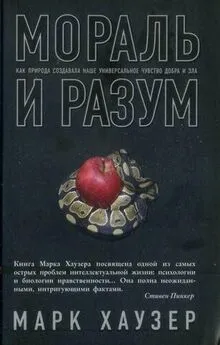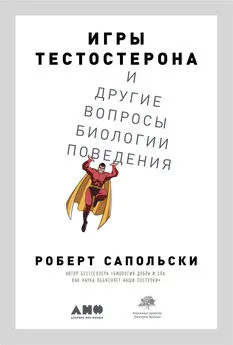Роберт Сапольски - Биология добра и зла. Как наука объясняет наши поступки
- Название:Биология добра и зла. Как наука объясняет наши поступки
- Автор:
- Жанр:
- Издательство:Альпина нон-фикшн
- Год:2019
- Город:Москва
- ISBN:978-5-0013-9051-0
- Рейтинг:
- Избранное:Добавить в избранное
-
Отзывы:
-
Ваша оценка:
Роберт Сапольски - Биология добра и зла. Как наука объясняет наши поступки краткое содержание
Биология добра и зла. Как наука объясняет наши поступки - читать онлайн бесплатно ознакомительный отрывок
Интервал:
Закладка:
101
W. Schultz, “Dopamine Signals for Reward Value and Risk: Basic and Recent Data,” Behav and Brain Functions 6 (2010): 24.
102
J. Cooper et al., “Available Alternative Incentives Modulate Anticipatory Nucleus Accumbens Activation,” SCAN 4 (2009): 409; D. Levy and P. Glimcher, “Comparing Apples and Oranges: Using Reward-Specific and Reward-General Subjective Value Representation in the Brain,” J Nsci 31 (2011): 14693.
103
P. Tobler et al., “Adaptive Coding of Reward Value by Dopamine Neurons,” Sci 307 (2005): 1642.
104
W. Schultz, “Dopamine Signals for Reward Value and Risk: Basic and Recent Data,” Behav and Brain Functions 6 (2010): 24; J. Cohen et al., “Neuron-Type-Specific Signals for Reward and Punishment in the Central Tegmental Area,” Nat 482 (2012): 85; J. Hollerman and W. Schultz, “Dopamine Neurons Report an Error in the Temporal Prediction of Reward During Learning,” Nat Nsci 1 (1998): 304; A. Brooks et al., “From Bad to Worse: Striatal Coding of the Relative Value of Painful Decisions,” Front Nsci 4 (2010): 1.
105
B. Knutson et al., “Neural Predictors of Purchases,” Neuron 53 (2007): 147.
106
P. Sterling, “Principles of Allostasis: Optimal Design, Predictive Regulation, Pathophysiology and Rational Therapeutics,” in Allostasis, Homeostasis, and the Costs of Adaptation , ed. J. Schulkin (Cambridge, MA: MIT Press, 2004).
107
B. Knutson et al., “Anticipation of Increasing Monetary Reward Selectively Recruits Nucleus Accumbens,” J Nsci 21 (2001): RC159.
108
G. Stuber et al., “Reward-Predictive Cues Enhance Excitatory Synaptic Strength onto Midbrain Dopamine Neurons,” Sci 321 (2008): 1690; A. Luo et al., “linkcing Context with Reward: A Functional Circuit from Hippocampal CA3 to Ventral Tegmental Area,” Sci 33 (2011): 353; J. O’Doherty, “Reward Representations and Reward-Related Learning in the Human Brain: Insights from Neuroimaging,” Curr Opinions in Neurobiol 14 (2004): 769; M. Cador et al., “Involvement of the Amygdala in Stimulus-Reward Associations: Interaction with the Ventral Striatum,” Nsci 30 (1989): 77; J. Britt et al., “Synaptic and Behavioral Profile of Multiple Glutamatergic Inputs to the Nucleus Accumbens,” Neuron 76 (2012): 790; G. Stuber et al., “Optogenetic Modulation of Neural Circuits That Underlie Reward Seeking,” BP 71 (2012): 1061; F. Ambroggi et al., “Basolateral Amygdala Neurons Facilitate Reward-Seeking Behavior by Exciting Nucleus Accumbens Neurons,” Neuron 59 (2008): 648.
109
S. Hyman et al., “Neural Mechanisms of Addiction: The Role of Reward-Related Learning and Memory,” Ann Rev of Nsci 29 (2006): 565; B. Lee et al., “Maturation of Silent Synapses in Amygdala-Accumbens Projection Contributes to Incubation of Cocaine Craving,” Nat Nsci 16 (2013): 1644. Обсуждение навязчивых поведенческих актов как одного из видов болезненной зависимости: S. Rauch and W. Carlezon, “Illuminating the Neural Circuitry of Compulsive Behaviors,” Sci 340 (2013): 1174; S. Ahmari et al., “Repeated Cortico-Striatal Stimulation Generates Persistent OCD-like Behavior,” Sci 340 (2013): 1234; E. Burguiere et al., “Optogenetic Stimulation of Lateral Orbitofronto-Striatal Pathway Suppresses Compulsive Behaviors,” Sci 340 (2013): 1243.
110
S. Flagel et al., “A Selective Role for Dopamine in Stimulus-Reward Learning,” Nat 469 (2011): 53; K. Burke et al., “The Role of the Orbitofrontal Cortex in the Pursuit of Happiness and More Specific Rewards,” Nat 454 (2008): 340.
111
P. Tobler et al., “Adaptive Coding of Reward Value by Dopamine Neurons,” Sci 307 (2005): 1642; C. Fiorillo et al., “Discrete Coding of Reward Probability and Uncertainty by Dopamine Neurons,” Sci 299 (2003): 1898.
112
B. Knutson et al., “Distributed Neural Representation of Expected Value,” J Nsci 25 (2005): 4806; M. Stefani and B. Moghaddam, “Rule Learning and Reward Contingency Are Associated with Dissociable Patterns of Dopamine Activation in the Rat Prefrontal Cortex, Nucleus Accumbens, and Dorsal Striatum,” J Nsci 26 (2006): 8810.
113
R. Habib and M. Dixon, “Neurobehavioral Evidence for the “Near-Miss” Effect in Pathological Gamblers,” J the Exp Analysis of Behav 93 (2010): 313; M. Hsu et al., “Neural Systems Responding to Degrees of Uncertainty in Human Decision-Making,” Sci 310 (2006): 1680.
114
A. Braun et al., “Dorsal Striatal Dopamine Depletion Impairs Both Allocentric and Egocentric Navigation in Rats,” Neurobiol of Learning and Memory 97 (2012): 402; J. Salamone, “Dopamine, Effort, and Decision Making,” Behavioral Nsci 123 (2009): 463; I. Whishaw and S. Dunnett, “Dopamine Depletion, Stimulation or Blockade in the Rat Disrupts Spatial Navigation and Locomotion Dependent upon Beacon or Distal Cues,” BBR 18 (1985): 11; J. Salamone and M. Correa, “The Mysterious Motivational Functions of Mesolimbic Dopamine,” Neuron 76 (2012): 470; H. Tsai et al., “Phasic Firing in Dopaminergic Neurons Is Sufficient for Behavioral Conditioning,” Sci 324 (2009): 1080; P. Phillips et al., “Sub-second Dopamine Release Promotes Cocaine Seeking,” Nat 422 (2003): 614; M. Pessiglione et al., “Dopamine-Dependent Prediction Errors Underpin Reward-Seeking Behavior in Humans,” Nat 442 (2008): 1042.
115
К сноске: M. Numan and D. Stoltzenberg, “Medial Preoptic Area Interactions with Dopamine Neural systemsin the Control of the Onset and Maintenance of Maternal Behavior in Rats,” Front Neuroendo 30 (2009): 46.
116
S. McClue et al., “Separate Neural Systems Value Immediate and Delayed Monetary Rewards,” Sci 306 (2004): 503; J. Jennings et al., “Distinct Extended Amygdala Circuits for Divergent Motivational States,” Nat 496 (2013): 224.
117
M. Howe et al., “Prolonged Dopamine Signaling in Striatum Signals Proximity and Value of Distant Rewards,” Nat 500 (2013): 575; Y. Niv, “Dopamine Ramps Up,” Nat 500 (2013): 533.
118
W. Schultz, “Subjective Neuronal Coding of Reward: Temporal Value Discounting and Risk,” Eur J Nsci 31 (2010): 2124; S. Kobayashi and W. Schultz, “Influence of Reward Delays on Responses of Dopamine Neurons,” J Nsci 28 (2008): 7837; S. Kim et al., “Prefrontal Coding of Temporally Discounted Values During Intertemporal Choice,” Neuron 59 (2008): 161; M. Roesch and C. Olson, “Neuronal Activity in Orbitofrontal Cortex Reflects the Value of Time,” J Neurophysiology 94 (2005): 2457; M. Bermudez and W. Schultz, “Timing in Reward and Decision Processes,” Philosophical Trans of the Royal Soc of London B 369 (2014): 20120468; B. Figner et al., “Lateral Prefrontal Cortex and Self-Control in Intertemporal Choice,” Nat Nsci 13 (2010): 538; K. Jimura et al., “Impulsivity and Self-Control During Intertemporal Decision Making linkced to the Neural Dynamics of Reward Value Representation,” J Nsci 33 (2013): 344; S. McClure et al., “Time Discounting for Primary Rewards,” J Nsci 27, 5796.
119
K. Ballard and B. Knutson, “Dissociable Neural Representations of Future Reward Magnitude and Delay During Temporal Discounting,” Neuroimage 45 (2009): 143.
120
A. Lak et al., “Dopamine Prediction Error Responses Integrate Subjective Value from Different Reward Dimensions,” PNAS 111 (2014): 2343.
121
V. Noreika et al., “Timing Deficits in Attention-Deficit / Hyperactivity Disorder (ADHD): Evidence from Neurocognitive and Neuroimaging Studies,” Neuropsychologia 51 (2013): 235; A. Pine et al., “Dopamine, Time, and Impulsivity in Humans,” J Nsci 30 (2010): 8888; W. Schultz, “Potential Vulnerabilities of Neuronal Reward, Risk, and Decision Mechanisms to Addictive Drugs,” Neuron 69 (2011): 603.
122
G. Brown et al., “Aggression in Humans Correlates with Cerebrospinal Fluid Amine Metabolites,” Psychiatry Res 1 (1979): 131; M. Linnoila et al., “Low Cerebrospinal Fluid 5-Hydroxyindoleacetic Acid Concentration Differentiates Impulsive from Nonimpulsive Violent Behavior,” Life Sci 33 (1983): 2609; P. Stevenson and K. Schildberger, “Mechanisms of Experience Dependent Control of Aggression in Crickets,” Curr Opinion in Neurobiol 23 (2013): 318; P. Fong and A. Ford, “The Biological Effects of Antidepressants on the Molluscs and Crustaceans: A Review,” Aquatic Toxicology 151 (2014): 4.
123
M. Linnoila et al., “Low Cerebrospinal Fluid 5-Hydroxyindoleacetic Acid Concentration Differentiates Impulsive from Nonimpulsive Violent Behavior,” Life Sci 33 (1983): 2609; J. Higley et al., “Excessive Mortality in Young Free- Ranging Male Nonhuman Primates with Low Cerebrospinal Fluid 5-Hydroxyindoleacetic Acid Concentrations,” AGP 53 (1996): 537; M. Åsberg et al., “5-HIAA in the Cerebrospinal Fluid: A Biochemical Suicide Predictor?” AGP 33 (1976): 1193; M. Bortolato et al., “The Role of the Serotonergic System at the Interface of Aggression and Suicide,” Nsci 236 (2013): 160.
124
H. Clarke et al., “Cognitive Inflexibility After Prefrontal Serotonin Depletion,” Sci 304 (2004): 878; R. Wood et al., “Effects of Tryptophan Depletion on the Performance of an Iterated PD Game in Healthy Adults,” Neuropsychopharmacology 1 (2006): 1075.
125
J. Dalley and J. Roiser, “Dopamine, Serotonin and Impulsivity,” Nsci 215 (2012): 42; P. Redgrave and R. Horrell, “Potentiation of Central Reward by Localized Perfusion of Acetylcholine and 5-Hydroxytryptamine,” Nat 262 (1976): 305; A. Harrison and A. Markou, “Serotonergic Manipulations Both Potentiate and Reduce Brain Stimulation Reward in Rats: Involvement of Serotonin-1A Receptors,” JPET 297 (2001): 316.
126
A. Duke, “Revisiting the Serotonin-Aggression Relation in Humans: A Meta-analysis,” Psych Bull 139 (2013): 1148.
127
A. Gopnik, “The New Neuro-Skeptics,” New Yorker , September 9, 2013.
128
C. Bukach et al., “Beyond Faces and Modularity: The Power of an Expertise Framework,” TICS 10 (2006): 159.
129
Жестокие матери и работы антибихевиористов: D. Maestripieri et al., “Neurobiological Characteristics of Rhesus Macaque Abusive Mothers and Their Relation to Social and Maternal Behavior,” Nsci Biobehav Rev 29 (2005): 51; R. Sullivan et al., “Ontogeny of Infant Fear Learning and the Amygdala,” in Cognitive Neuroscience IV , ed. M. Gazzaniga (Cambridge, MA: MIT Press, 2009), 889.
Читать дальшеИнтервал:
Закладка:





![Роберт Сапольски - Игры тестостерона и другие вопросы биологии поведения [litres]](/books/1074102/robert-sapolski-igry-testosterona-i-drugie-vopros.webp)




